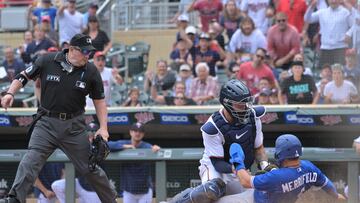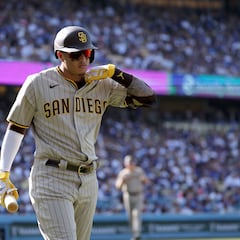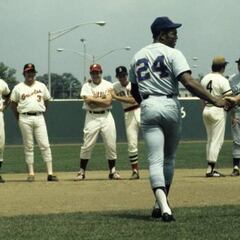What is the Buster Posey rule in MLB, and how is it applied?
With the controversial reversal in the Blue Jays win over the Twins in extra innings, we take a hard look at the Buster Posey rule and how it is applied


Tied ball game, 2-2 in the tenth inning. Cavan Biggio pops a ball into shallow left for out number two and Whit Merrifield tags up to try and win the game. Tim Beckham’s throw is on a rope and Gary Sanchez applies the tag for out number three. The Twins live to fight on. But hold up, maybe not.
Toronto appealed the decision, arguing that Sanchez was blocking the plate, and New York based replay umpire Jordan Baker agreed. He reversed the call and the run scored, ending the game. Twins manager Rocco Baldelli was furious, leading to his ejection from the game. He later called the decision to overturn the call “one of the most chickenshit things I’ve ever seen on a baseball field. It’s one of the worst moments I think we’ve seen of umpiring in any game I’ve ever been a part of in baseball, and I think it was pathetic what just played out.’’
Blue Jays beat the Twins in extra innings after a controversial overturned call at the plate 👀
— B/R Walk-Off (@BRWalkoff) August 7, 2022
(via @Sportsnet)pic.twitter.com/jIZOXuGuUd
In the press and on social media the lines have been drawn between those who are saying that the catcher can never block the plate and those decrying baseball’s turn away from allowing collisions, calling for the abolition of the so-called “Buster Posey Rule.” Perhaps it is a good time to actually look at that rule and what it means for baseball.
To look at the whole situation in the round, you have to go back to the bad old, good-old-days, when trucking a player was considered the “proper” way to try and make it safely to the base. Just like when the police set up a road block for a criminal, they can either avoid it or attack it. Pre Buster Posey, MLB was all-in on the attack method.
Rocco Baldelli not holding back: "It's one of the worst moments I think we've seen of umpiring, in any game I've ever been a part of in baseball. I think it was pathetic." #MNTwins pic.twitter.com/mSX3q1kLrp
— Bally Sports North (@BallySportsNOR) August 7, 2022
As a retired catcher, I have a lot of sympathy for the idea of allowing this type of play to continue. I have been trucked many times in my career and only lost the ball a handful of those. Just as base runners were taught to go in hard, catchers were taught to lead with the shinguard. Many baserunners came in hot, all set to give me a wallop and wound up coming out second-best in the contest.
I remember watching from the dugout as team mate, and ex-Miami Hurricanes catcher, Jesse Quiñones dropped a baserunner in his tracks with a hard tag to the face. Baseball could often be pretty brutal.
Good times…
But here is the thing, though: having said all of that, I don’t for one minute want it to go back to the way it was. The rule is fine just the way it is.
The rule got its name by being imposed in response to the season-ending broken leg that Buster Posey suffered when Scott Cousins came off his line for the plate in an effort to knock the ball loose. The MLB instituted a rule change, together with a clarification of an existing rule, that it is worth sharing the text of in full here.
Rule 6.01(i) Collisions at Home Plate
(1) A runner attempting to score may not deviate from his direct pathway to the plate in order to initiate contact with the catcher, or otherwise initiate an avoidable collision. If, in the judgment of the umpire, a runner attempting to score initiates contact with the catcher in such a manner, the umpire shall declare the runner out (regardless of whether the catcher maintains possession of the ball). In such circumstances, the umpire shall call the ball dead, and all other base runners shall return to the last base touched at the time of the collision. If the runner slides into the plate in an appropriate manner, he shall not be adjudged to have violated Rule 6.01(i).
(2) Unless the catcher is in possession of the ball, the catcher cannot block the pathway of the runner as he is attempting to score. If, in the judgment of the umpire, the catcher without possession of the ball blocks the pathway of the runner, the umpire shall call or signal the runner safe. Not withstanding the above, it shall not be considered a violation of this Rule 6.01(i)(2) if the catcher blocks the pathway of the runner in a legitimate attempt to field the throw (e.g., in reaction to the direction, trajectory or the hop of the incoming throw, or in reaction to a throw that originates from a pitcher or drawn-in infielder). In addition, a catcher without possession of the ball shall not be adjudged to violate this Rule 6.01(i)(2) if the runner could have avoided the collision with the catcher (or other player covering home plate) by sliding.
Whew! That is a lot to take in, but the long and the short of it is this:
- the player MUST stay on the direct line to the plate and
- the catcher must give the runner a lane to the plate UNLESS he has possession of the ball.
Those are some important distinctions there, so let’s unpack this a little. Contrary to what many fans think, a clear line to the plate does not mean the entire base path. Far from it. If the runner can touch the plate without having to go through extensive yoga positions then he has a path open to him.
The most important one to remember is that a catcher can indeed, and in fact SHOULD, block the plate once he has possession of the ball. Once the ball is in his hand, any path to the plate should be closed down immediately, and this is completely in keeping with the rule as it stands.
There is no need to change or abolish the Buster Posey Rule, it is worded perfectly the way it is. What does need to be altered, though, is how that rule is interpreted by the umpiring crew. One thing is glaringly obvious and that is that Jordan Baker got this call completely wrong.
Rocco Baldelli was right when he called this a low moment in baseball umpiring. It is clearly plain to see that Sanchez left a clear path to the plate open until he had possession of the baseball. And then he did exactly what every catcher should do, what older catchers spent our lives doing and what young catchers should be trained to do, and that is that he cut off access to the plate. Legally.
This isn't blocking the plate. This is the runner sliding into the catcher. pic.twitter.com/ulLknR5hKQ
— 𝕊𝕔𝕠𝕥𝕥 ℝ. ℕ𝕖𝕝𝕤𝕠𝕟, ℂℙ 🇺🇸🎙 (@snelson66) August 7, 2022
Whit Merrifield said after the game, “I saw Gary straddling home plate. So, I tried to just slide in to him straight in as best I could.” He argued that Sanchez left no lane to slide in, but it is clear from the video that statement is not true. “He’s got to give me a lane to slide in. And I didn’t think I had one.”
Sanchez, for his part, had this to say about the play: “I thought it was a clean play. He didn’t use the outside lane, he went on top of me. If I lower my knee before I get the ball, or before the runner gets to home plate, then I’m blocking the plate. That’s not what I did. I caught the ball and then went down to tag him. It’s a clean play.”
He didn’t use the outside lane.
He went on top of me.
It’s a clean play.
Related stories
Jordan Baker said that he overturned the call based on Sanchez moving to foul territory in order to deny access to the plate, but based on the rule, Sanchez is allowed to do exactly that. Once he has possession of the ball, he can sit on top of the plate if he wants to.
This comment in the MLB rule book makes it clear the only time a runner should be called safe is if *BOTH* a catcher is blocking the plate while not in a legitimate attempt to field the throw *AND* the runner would not have been called out had the catcher not blocked it. pic.twitter.com/XWPQui2kpS
— Tom Froemming (@TFTwins) August 8, 2022
It is often difficult, especially in baseball, to not see every thing that happens as an assault on the fabric of the game itself. With rule 6.01(i) though, baseball did something that perhaps you are not used to seeing. They saw a need for a rule change and made the correct adjustment. No matter what it looks like from the outside, the rule as it stands today is just fine. Perhaps someone should take the time to teach it to Jordan Baker, though.

